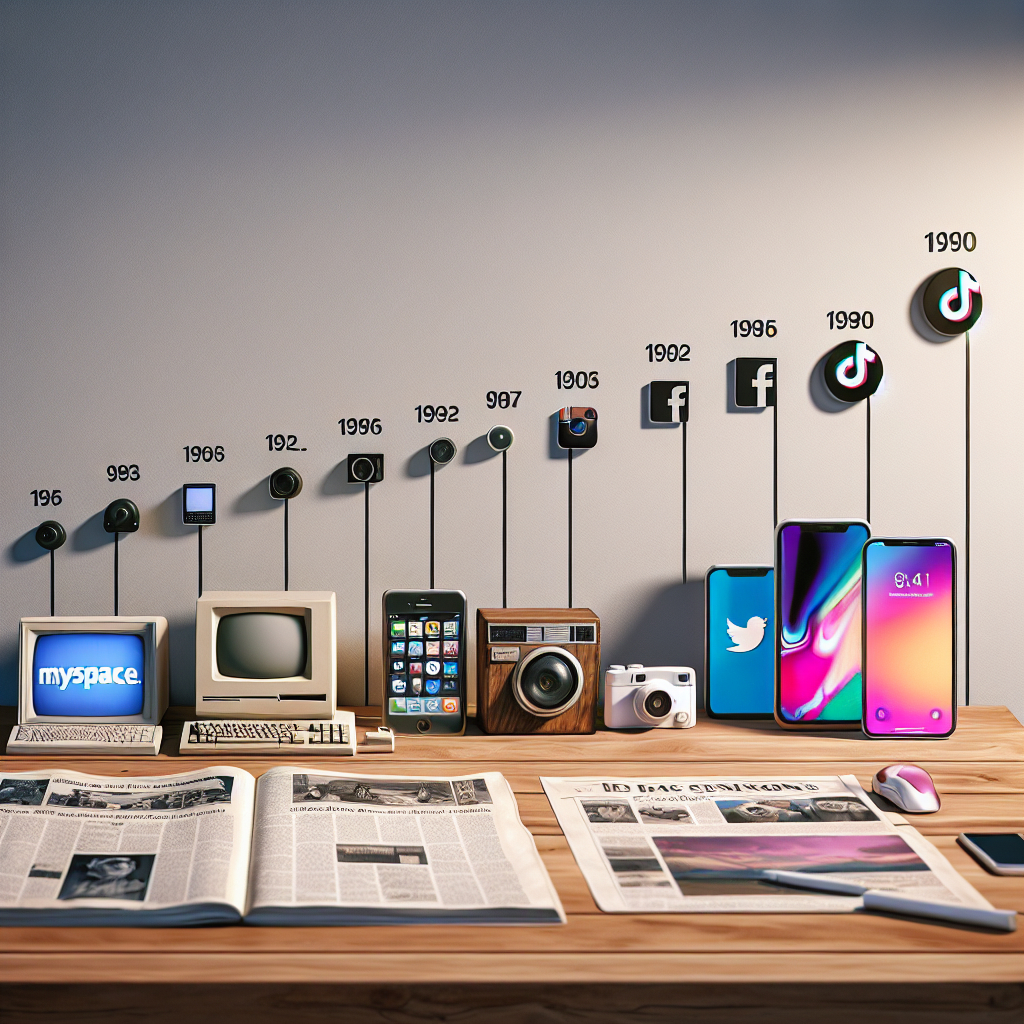Social media has undergone a remarkable transformation since its inception, evolving from simple platforms for connecting with friends to complex ecosystems that influence nearly every aspect of modern life. This article explores the journey of social media from the early days of MySpace to the current dominance of TikTok, examining the technological advancements, cultural shifts, and societal impacts along the way.
The Early Days: MySpace and the Birth of Social Networking
In the early 2000s, MySpace emerged as one of the first major social networking platforms, revolutionizing the way people interacted online. Launched in 2003, MySpace allowed users to create personalized profiles, connect with friends, and share music, photos, and blog posts. It quickly became a cultural phenomenon, attracting millions of users and setting the stage for the social media boom that would follow.
MySpace’s success can be attributed to several key features. First, it offered a high degree of customization, allowing users to personalize their profiles with HTML and CSS. This not only made profiles visually unique but also encouraged users to learn basic coding skills. Second, MySpace’s focus on music and entertainment helped it attract a younger demographic, with many bands and artists using the platform to promote their work and connect with fans.
However, MySpace’s dominance was short-lived. By the late 2000s, it faced stiff competition from a new player in the social media landscape: Facebook. Launched in 2004, Facebook offered a cleaner, more user-friendly interface and quickly gained popularity among college students. As Facebook expanded its user base and introduced new features, MySpace struggled to keep up, eventually losing its status as the leading social networking site.
The Rise of Facebook and the Mainstreaming of Social Media
Facebook’s rise to prominence marked a significant turning point in the evolution of social media. Unlike MySpace, which focused on individual expression and entertainment, Facebook emphasized real-world connections and community building. Its „real name” policy encouraged users to create authentic profiles, fostering a sense of trust and accountability that was lacking on other platforms.
One of Facebook’s most significant contributions to the social media landscape was the introduction of the News Feed in 2006. This feature allowed users to see a continuous stream of updates from their friends, making it easier to stay connected and engaged. The News Feed also paved the way for the development of algorithms that personalized content based on user behavior, a concept that would become central to the success of future social media platforms.
As Facebook grew, it expanded its features to include photo and video sharing, events, groups, and pages for businesses and public figures. These additions transformed Facebook from a simple social networking site into a comprehensive platform for communication, entertainment, and commerce. By the early 2010s, Facebook had become the dominant social media platform, boasting over a billion active users worldwide.
The Emergence of Visual and Mobile-First Platforms
While Facebook continued to dominate the social media landscape, new platforms began to emerge that catered to different user preferences and behaviors. One of the most significant trends in this period was the shift towards visual and mobile-first platforms, driven by the increasing popularity of smartphones and the growing importance of visual content.
Instagram, launched in 2010, was one of the first platforms to capitalize on this trend. With its focus on photo and video sharing, Instagram quickly gained a large and dedicated user base. Its simple, mobile-friendly interface made it easy for users to capture and share moments from their daily lives, while features like filters and hashtags encouraged creativity and discovery.
Another key player in the visual and mobile-first space was Snapchat, which launched in 2011. Snapchat introduced the concept of ephemeral content, with photos and videos that disappeared after being viewed. This unique approach to content sharing resonated with younger users, who appreciated the spontaneity and privacy it offered. Snapchat also pioneered the use of augmented reality (AR) with its popular lenses and filters, setting the stage for future innovations in social media.
The Rise of TikTok and the Era of Short-Form Video
In recent years, TikTok has emerged as the latest social media sensation, capturing the attention of millions of users worldwide. Launched in 2016 by the Chinese company ByteDance, TikTok focuses on short-form video content, with users creating and sharing 15 to 60-second clips set to music, sound bites, and other audio.
TikTok’s success can be attributed to several factors. First, its algorithm-driven „For You” page delivers a highly personalized and engaging user experience, showcasing content that is tailored to individual interests and preferences. This has helped TikTok maintain high levels of user engagement and retention. Second, TikTok’s emphasis on creativity and self-expression has resonated with younger users, who enjoy the platform’s playful and dynamic nature.
Another key aspect of TikTok’s appeal is its community-driven culture. Challenges, trends, and viral content play a central role in the TikTok experience, encouraging users to participate and contribute to the platform’s ever-evolving ecosystem. This sense of community and shared experience has helped TikTok build a loyal and active user base, making it one of the fastest-growing social media platforms in history.
The Impact of Social Media on Society
The evolution of social media has had profound implications for society, influencing everything from communication and entertainment to politics and commerce. On the positive side, social media has made it easier for people to stay connected with friends and family, discover new interests, and access information and resources. It has also provided a platform for marginalized voices and facilitated social and political movements, such as the Arab Spring and the Black Lives Matter movement.
However, the rise of social media has also brought challenges and concerns. Issues such as privacy, misinformation, and the impact of social media on mental health have become increasingly prominent. The spread of fake news and the manipulation of information on social media platforms have raised questions about the role of these platforms in shaping public opinion and influencing elections. Additionally, the pressure to present a curated and idealized version of oneself on social media has been linked to increased anxiety, depression, and other mental health issues.
As social media continues to evolve, it is essential to address these challenges and find ways to harness the positive aspects of these platforms while mitigating their negative impacts. This will require collaboration between technology companies, policymakers, and users to create a more balanced and responsible social media ecosystem.
The Future of Social Media
Looking ahead, the future of social media is likely to be shaped by several key trends and developments. One of the most significant trends is the continued rise of video content, particularly short-form video. Platforms like TikTok have demonstrated the power of short, engaging videos to capture users’ attention and drive engagement, and other social media platforms are likely to follow suit by incorporating similar features.
Another important trend is the increasing integration of augmented reality (AR) and virtual reality (VR) into social media experiences. AR and VR have the potential to create more immersive and interactive experiences, allowing users to engage with content in new and exciting ways. For example, Facebook’s parent company, Meta, has been investing heavily in the development of the metaverse, a virtual world where users can interact with each other and digital content in a fully immersive environment.
Privacy and data security will also continue to be critical issues for the future of social media. As users become more aware of the ways in which their data is collected and used, there will be increasing demand for greater transparency and control over personal information. Social media platforms will need to prioritize user privacy and implement robust security measures to build trust and maintain user confidence.
Finally, the future of social media will be shaped by the ongoing evolution of artificial intelligence (AI) and machine learning. These technologies have the potential to enhance the personalization and relevance of social media content, improve moderation and content filtering, and enable new forms of interaction and engagement. However, the use of AI also raises ethical and regulatory questions that will need to be addressed to ensure that these technologies are used responsibly and fairly.
In conclusion, the evolution of social media from MySpace to TikTok has been marked by significant technological advancements, cultural shifts, and societal impacts. As social media continues to evolve, it will be essential to navigate the challenges and opportunities that arise, ensuring that these platforms remain a positive and empowering force in our lives.



